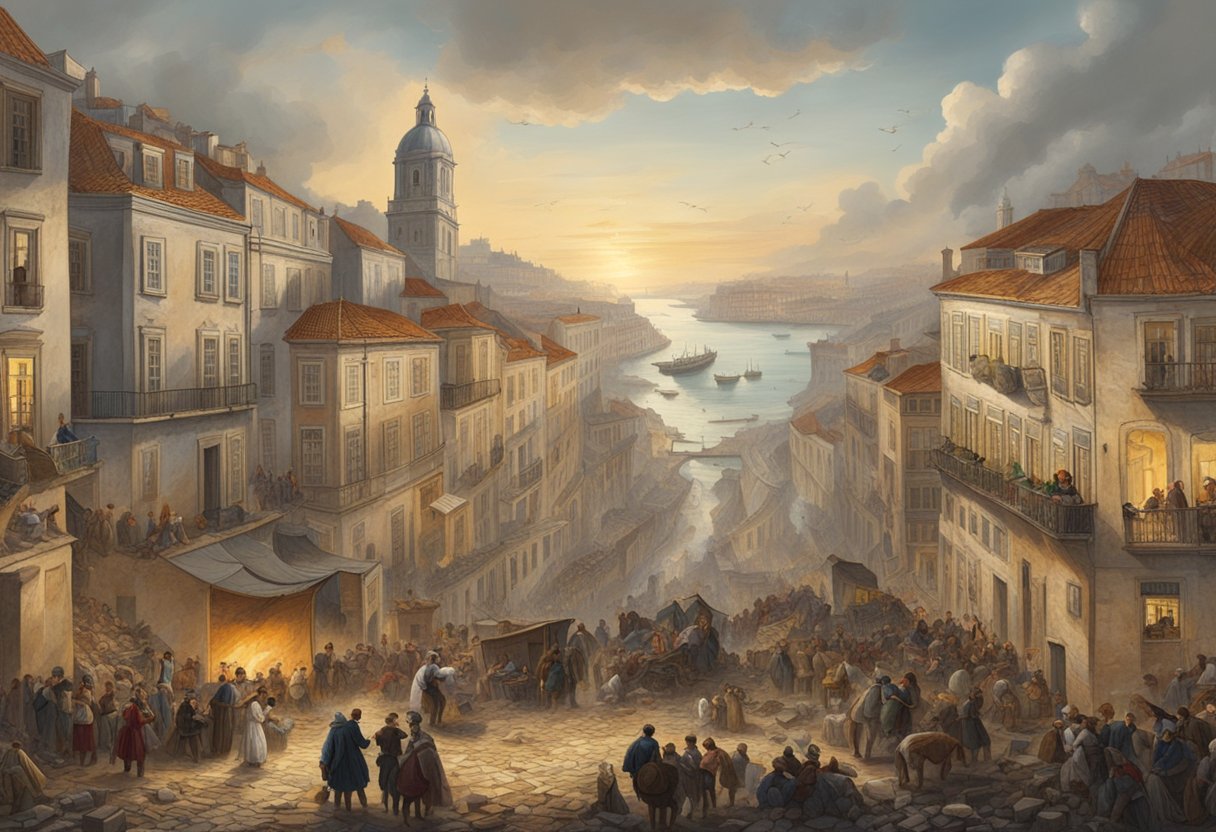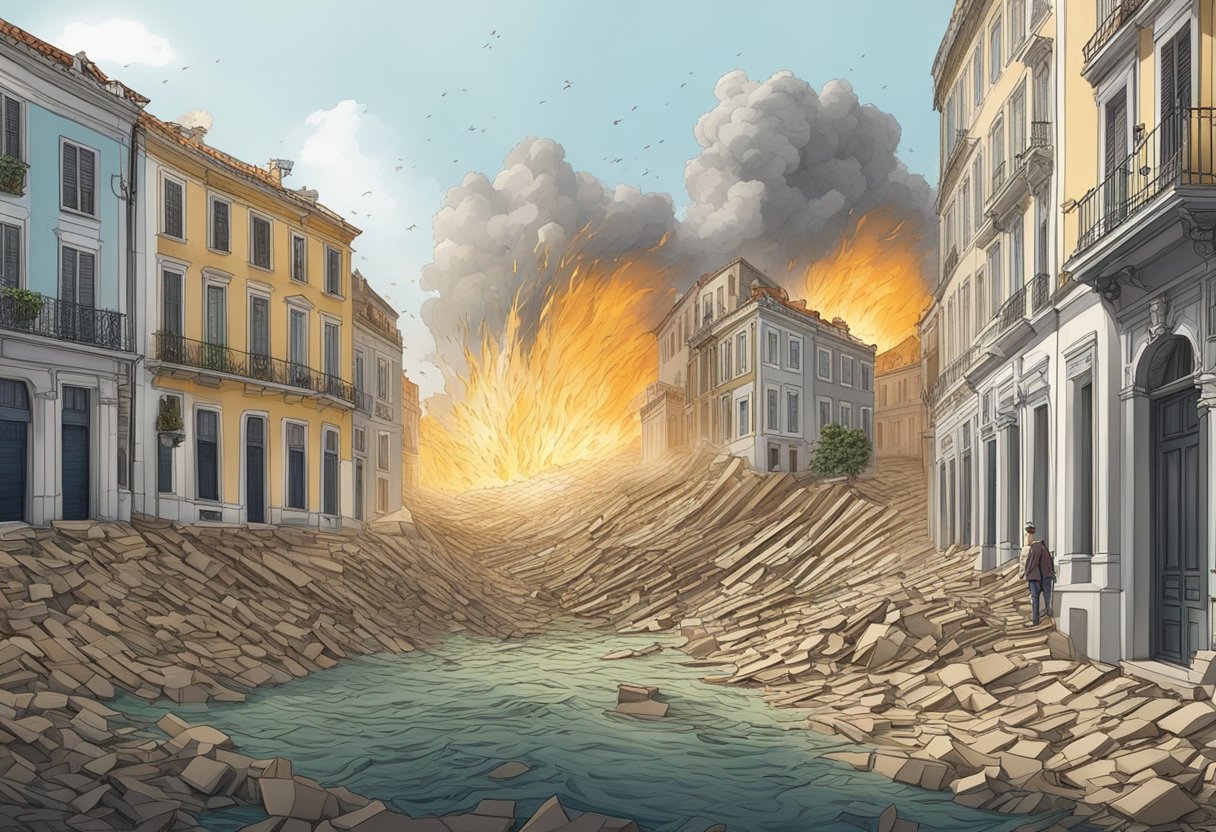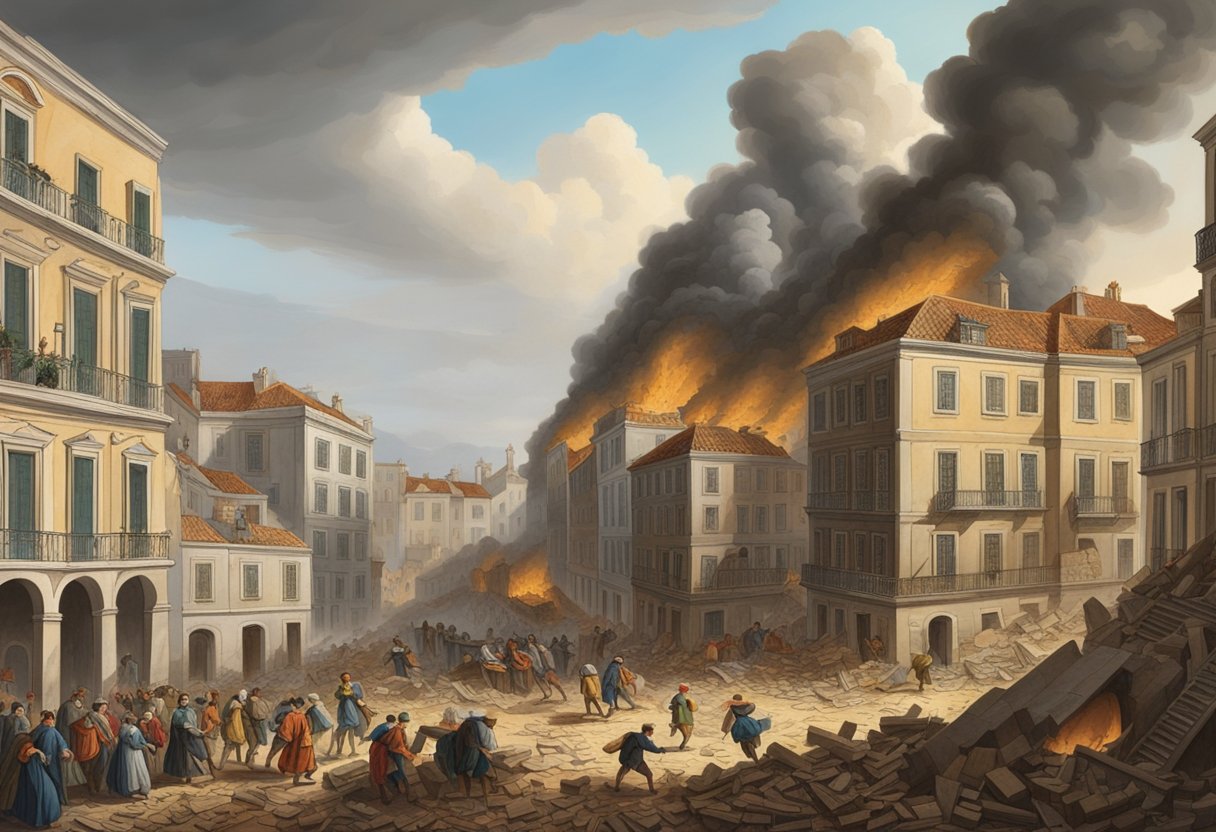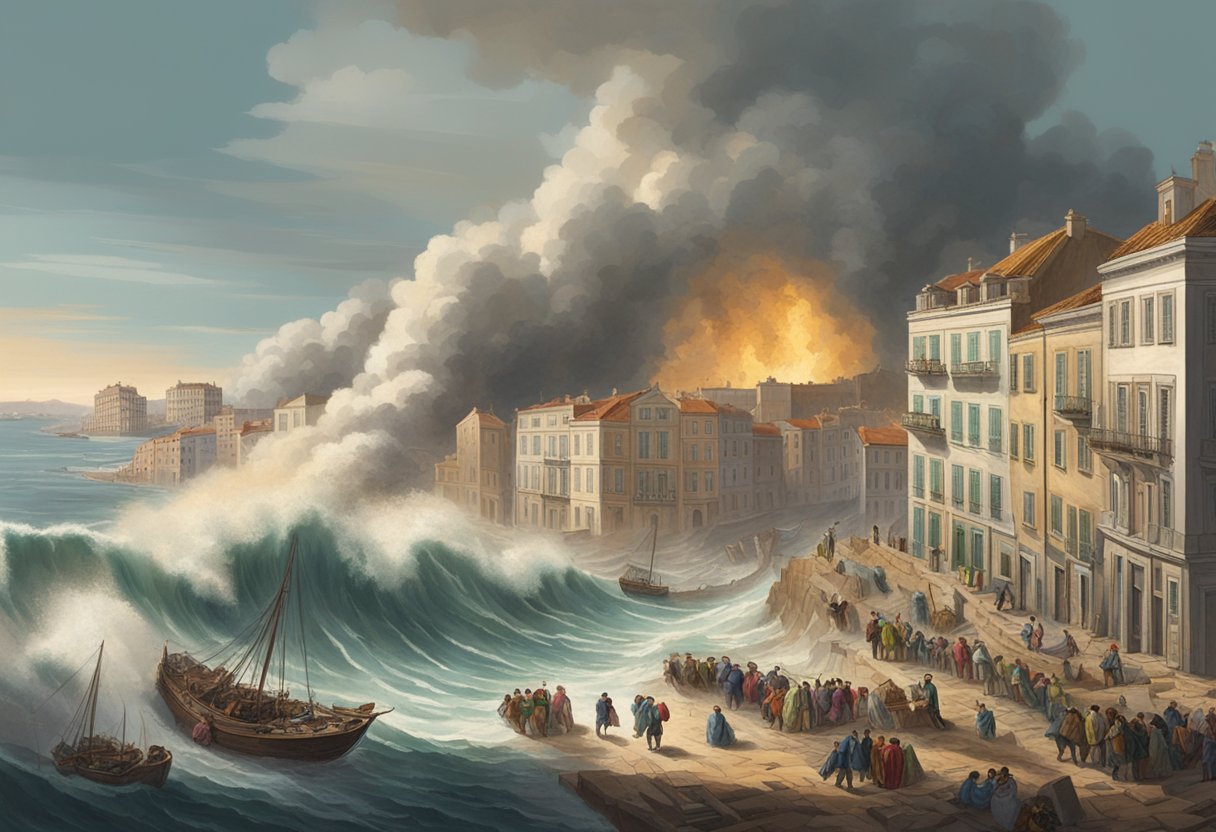The 1755 Lisbon Earthquake: Catalyst for Advances in Seismology

The 1755 Lisbon Earthquake stands as one of the most significant natural disasters in European history. On the morning of November 1, 1755, Lisbon was almost completely destroyed due to a powerful earthquake, followed by devastating fires and a massive tsunami. This catastrophic event caused immense loss of life and extensive damage, altering the course of Lisbon's history and architecture.
Modern research indicates that the seismic activity originated from faulting in the seafloor along the tectonic plate boundaries of the mid-Atlantic. The impact of the earthquake was felt far beyond Portugal, with tsunami waves reaching as high as 65 feet in Cádiz, Spain. The disaster also contributed to advancements in earthquake studies, with the event marking a pivotal moment in the development of modern seismology.
The Great Lisbon Earthquake of 1755 not only reshaped the physical landscape but also had lasting effects on society and science. Its aftermath spurred efforts to better understand seismic phenomena, leading to more effective building codes and safety protocols. The legacy of this earthquake emphasizes the enduring need for preparedness and resilience in the face of natural disasters.
Historical Context
The 1755 Lisbon Earthquake not only devastated Lisbon but also had significant effects on Europe and influenced scientific and philosophical thought during the European Enlightenment.
Lisbon Before the Earthquake
Lisbon, the capital of Portugal, was a thriving city before 1755. It was known for its Manueline architecture, a unique Portuguese style. Key landmarks included the Royal Ribeira Palace and the Lisbon Cathedral. Lisbon was a hub of cultural and economic activity, and its strategic location on the Atlantic coast facilitated trade between Europe, Africa, and the Americas. The city's prosperity and architectural beauty were points of national pride for Portugal.
The Impact of the Earthquake on Europe
The earthquake struck Lisbon on November 1, 1755, at around 9:40 AM, causing widespread destruction. The subsequent tsunami and fires compounded the damage. Famed structures like the Royal Ribeira Palace and many Manueline buildings were lost. The disaster reached far beyond Portugal, influencing contemporary European thought.
Voltaire and Immanuel Kant, among other Enlightenment philosophers, wrote about the quake. Voltaire's "Candide" used it to critique optimism, while Kant tried to understand the event scientifically. This catastrophe revealed the potential for such studies to save lives and aid recovery efforts, laying the groundwork for modern seismology.
The earthquake's impact on Europe's intellectual landscape was profound. It showed the fragility of human achievements and urged a more scientific approach to understanding natural disasters.
The Earthquake Event

The 1755 Lisbon Earthquake, also known as the Great Lisbon Earthquake, was one of the most destructive and deadliest earthquakes in history. This section will cover the timeline of the disaster, scientific insights, and the widespread effects beyond Lisbon.
Chronology of the Disaster
On November 1, 1755, at around 9:40 in the morning, the earthquake struck Lisbon with devastating force. The initial shocks were followed by a series of violent tremors. Buildings collapsed, and the quake’s magnitude was later estimated to be between 8.5 and 9.0.
Shortly after the tremors, a massive tsunami hit the coast. The waves in Lisbon reached about 20 feet high, further damaging the city. The tsunami also struck Cadiz in Spain, with waves about 65 feet high. The disaster didn’t end there; fires broke out across Lisbon, consuming buildings and causing further destruction.
Scientific Analysis of the Earthquake
Modern research indicates that the seismic activity was caused by faulting of the seafloor along tectonic plate boundaries in the mid-Atlantic. The epicenter of the earthquake is believed to be offshore, though its exact location remains uncertain.
The Lisbon earthquake led to the birth of modern seismology and earthquake engineering. Scientists began studying the earthquake’s patterns, leading to an understanding of seismic waves and fault behavior. This event highlighted the need for improved building codes to withstand seismic activity.
Effects Beyond Lisbon
The impact of the 1755 Lisbon Earthquake extended far beyond the city. The tsunami waves traveled across the Atlantic, reaching as far as the Caribbean island of Martinique. Coastal areas in Morocco were also affected, experiencing significant damage.
In Spain, the Andalusian coast, especially Cadiz, faced severe destruction from the tsunami waves. The quake and its aftermath influenced European Enlightenment thinking, sparking debates on natural disasters and human suffering.
The earthquake's shockwaves were felt throughout the Algarve region and even as far afield as Finland. These widespread effects demonstrated the far-reaching power of such natural disasters, adding to the urgency for better preparedness and resilience.
Consequences and Response

The 1755 Lisbon earthquake had far-reaching consequences, including immediate devastation and long-term political and social changes. The city's response shaped future policies and science.
Immediate Aftermath and Human Impact
The earthquake struck Lisbon on November 1, 1755, at 9:40 AM. It was one of the deadliest in history, killing between 60,000 to 100,000 people. The seismic event was followed by massive fires and a tsunami that further devastated the city.
Churches, buildings, and homes were destroyed, leaving countless people homeless. Efforts to search for survivors were hampered by ongoing tremors and widespread fires. The death toll was exacerbated by structural collapses and the ensuing chaos.
In addition, the city faced a public health crisis due to the decaying bodies and lack of clean water.
Political and Social Repercussions
King Joseph I of Portugal and his Prime Minister, the Marquis of Pombal, were instrumental in the response to the disaster. Pombal famously asserted, "Bury the dead and feed the living." He led reconstruction efforts, implementing new building codes and urban planning principles.
Pombal's leadership marked the inception of modern disaster response strategies. His methods reduced political tensions temporarily, but his centralization of power sparked debates.
The earthquake also influenced European Enlightenment thinkers, leading to discussions on natural disasters' causes and human suffering. Voltaire's "Candide" notably critiques philosophical optimism in light of such catastrophic events.
Reconstruction and Urban Development

The reconstruction of Lisbon after the 1755 earthquake led to significant changes in urban planning and architecture. The Pombaline reforms introduced innovative ideas in building design to withstand future earthquakes and rationalized the city layout.
The Pombaline Reforms
The Marquis of Pombal spearheaded the rebuilding efforts. He took a methodical approach to reconstructing Lisbon's downtown area, known as Baixa Pombalina. This area became one of the first examples of earthquake-resistant architecture.
Key features included earthquake engineering techniques like the Pombaline cage, a wooden framework inside the walls that provided flexibility during seismic activity. He also prioritized open space in urban design to prevent the spread of fires, which had compounded the disaster's destruction.
Libraries and palaces were rebuilt, incorporating these reforms to ensure better safety. The reconstruction included modern streets and large public squares, creating an organized layout that facilitated civilian and military movements.
Innovations in Urban Planning
Lisbon's new urban plan was revolutionary for its time. Streets were laid out in a grid pattern, a stark contrast to the former narrow and winding streets. This rational design simplified navigation and improved traffic flow.
Architects and planners used pre-fabricated materials, accelerating the rebuilding process. Public buildings like the downtown libraries and government structures were constructed with standardized designs to ensure uniformity and resilience.
The new urban layout also created specific zones for commercial, residential, and institutional buildings, introducing a level of urban order not seen before in Lisbon. Broadway avenues and well-spaced buildings ensured light and air reached all parts of the downtown area.
These efforts marked a turning point in urban development, influencing cities beyond Portugal's borders and setting a precedent for modern urban planning and disaster preparedness.
Advancements in Seismology

The 1755 Lisbon earthquake marked a significant shift in how humanity understood earthquakes. Rather than viewing them solely as acts of divine will, it spurred scientific inquiry and the development of new fields like earthquake engineering.
From Theodicy to Scientific Perspective
Before 1755, many believed earthquakes were divine punishments. Theodicy discussions were common among philosophers. The Lisbon earthquake changed this mindset. Thinkers like Voltaire and Immanuel Kant argued for natural explanations.
Voltaire criticized religious interpretations in his work "Candide." Immanuel Kant suggested that natural forces caused the quake. This shift was crucial for modern seismology. It laid the groundwork for a more scientific approach to studying tremors.
Development of Earthquake Engineering
Post-1755, the demand for safer buildings surged. This led to the birth of earthquake engineering. Engineers and architects worked on methods to minimize earthquake damage. They studied faulting and seismic hazards to make structures more resilient.
Modern techniques include seismic hazard assessment and retrofitting older buildings. These advancements have saved countless lives by ensuring structures can better withstand quakes. The field continues to evolve, enhancing safety and understanding geodynamics.
Cultural Impact
The 1755 Lisbon earthquake had a profound influence on European culture, inspiring significant works in literature and art while also prompting important religious and philosophical debates.
The Earthquake in Literature and Art
The disaster deeply affected literature and art throughout Europe. Voltaire's poem "Candide" famously criticizes the optimistic philosophy of the time, using the earthquake as a central event that questions the nature of good and evil.
Painters like Rubens and Correggio captured the event's dramatic scenes in their works. While Rubens didn't paint the Lisbon earthquake directly, his style influenced later representations of disaster.
The earthquake also inspired theodicy discussions, exploring why a benevolent God would allow such suffering. This was reflected in various artistic presentations that depicted the horrors of the event with striking realism.
Many European intellectuals began to use the event to critique Catholic doctrine, making it a symbol of the Enlightenment's challenge to religious authority.
Religious and Philosophical Interpretations
Religious thinkers struggled to interpret the earthquake within the context of their faith. For many in Catholic countries, the event was viewed as divine punishment. The massive destruction on All Saints' Day added to the idea that God was displeased.
Philosophers like Voltaire used the earthquake to question the righteousness of divine justice. His critique of theodicy—the justification of God's goodness despite the existence of evil—gained momentum.
This period saw a rise in secular thinking and skepticism. The Lisbon earthquake challenged the believers and spurred debates that would shape modern philosophical discourse. The event underscored the limitations of human understanding in the face of natural disasters.

